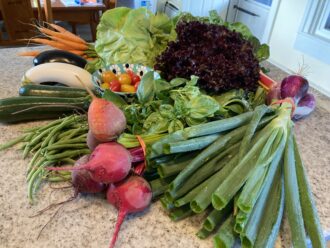Harvest
| Yield | An average of ¾ pint per row foot (in a dry year over a 2-week harvest window) Expect different yield numbers for everbearing berries. |
| Standards | Harvesting1 15 quarts or 25 pints per person, per hour |
| Tools and supplies needed | Boxes with pint or quart baskets and, if needed, netting to cover berries. Bowls to pick in are optional if berries aren’t picked directly into pints or quarts. |
| 1Harvest rates don't include the time required to transport crops from the field to a wash and pack shed or storage facility. | |
Ready-to-harvest and quality indicators
- Strawberries are ripe (75% of their surface shows a pink or red color) and firm.
- Discard overripe berries, as they don’t hold up until the time of delivery.
- Berries are at least ¾ inch in diameter and free from blemishes or pest damage. Minor defects (less than 10%) are acceptable, but there’s zero tolerance for decay or mold.
Harvest procedures
- Wash hands before harvesting strawberries.
- Pick berries in the morning when they are dry.
- Each person takes 1 row of strawberries, picking into a bowl or directly into pint baskets.
- When the bowl is filled, pour the berries into the pint containers inside a small box.
- Fill the pint containers until they have a rounded top, then place a net over the top.
- Make sure to keep the harvest crew in 1 section of the field at a time.
- Mark where you stop so you can start there the next day.
- Place the berries in a cooler within an hour of picking. A person who wasn’t harvesting should do this. Otherwise, make sure you have clean hands and boots before entering the packing shed.
Additional resources
Packing and storage summary for strawberries
| Packing in the field | In bowls or directly into pint or quart boxes |
| Packing for delivery | 12 pints or 8 quarts per box See the International Federation for Produce Standards for the correct PLU code. Add the prefix 9 for organic crops. |
| Storage | Store in a cooler overnight. Don’t put the crop in a cooler if delivering on the same day as harvest. Store at 32°F and 90% humidity for 5–7 days. |
This material is based upon work that is supported by the National Institute of Food and Agriculture, U.S. Department of Agriculture through the Sustainable Agriculture Research and Education (SARE) program. Any opinions, findings, conclusions, or recommendations expressed in this publication are those of the author(s) and should not be construed to represent any official USDA or U.S. Government determination or policy.
